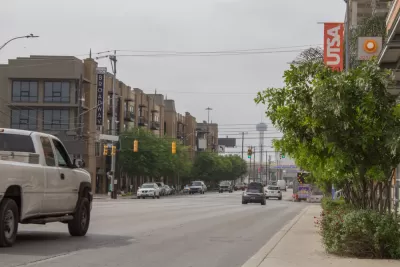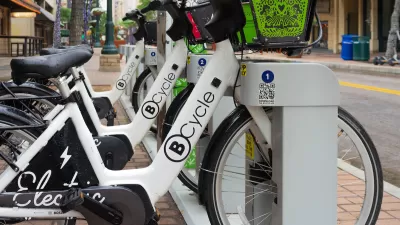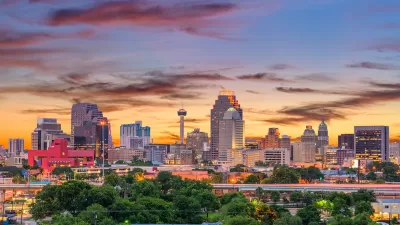The agency argues that the city cannot introduce lane reductions on a state road, putting a long-planned bike lane project in jeopardy and superseding local decisionmaking.

Bike advocates often face an uphill battle in their efforts to build safer bike infrastructure in their cities. But even well-meaning local efforts to improve road conditions for people on bikes can be thwarted by state agencies. This is the case with San Antonio, as reported by Jared Brey in Governing.
“Like a lot of other big cities, San Antonio has tried to make some of its streets safer for bikers and pedestrians. In 2017, voters approved a bond measure to fund a range of public-realm improvements, including 200 miles of new sidewalks.” One project funded by this bond, a two-mile redesign of Broadway that would have added bike lanes, was nixed by the Texas Department of Transportation, who claimed that, as a state route, the road could not be narrowed from its six driving lanes, despite having worked with the city on the project for years.
“The moves are in keeping with state leaders’ focus on reducing traffic congestion on state roads, and part of a broader culture war over transportation” that Planetizen readers are undoubtedly familiar with (see examples here, here, here, and here, for starters). City planning professor Sara Bronin points to the inherent conservative nature of engineers, saying, “What we’re seeing in the traffic context is that the inclination to rely on established safety standards has resulted in complacency, and that has led to these standards not being questioned by the majority of decision-makers.”
For now, San Antonio policymakers are faced with a project in limbo until TxDOT agrees to a plan.
FULL STORY: Can San Antonio Become a Better Bike City? Not on State Roads.

Trump Administration Could Effectively End Housing Voucher Program
Federal officials are eyeing major cuts to the Section 8 program that helps millions of low-income households pay rent.

Planetizen Federal Action Tracker
A weekly monitor of how Trump’s orders and actions are impacting planners and planning in America.

Ken Jennings Launches Transit Web Series
The Jeopardy champ wants you to ride public transit.

Washington Legislature Passes Rent Increase Cap
A bill that caps rent increases at 7 percent plus inflation is headed to the governor’s desk.

From Planning to Action: How LA County Is Rethinking Climate Resilience
Chief Sustainability Officer Rita Kampalath outlines the County’s shift from planning to implementation in its climate resilience efforts, emphasizing cross-departmental coordination, updated recovery strategies, and the need for flexible funding.

New Mexico Aging Department Commits to Helping Seniors Age ‘In Place’ and ‘Autonomously’ in New Draft Plan
As New Mexico’s population of seniors continues to grow, the state’s aging department is proposing expanded initiatives to help seniors maintain their autonomy while also supporting family caregivers.
Urban Design for Planners 1: Software Tools
This six-course series explores essential urban design concepts using open source software and equips planners with the tools they need to participate fully in the urban design process.
Planning for Universal Design
Learn the tools for implementing Universal Design in planning regulations.
Heyer Gruel & Associates PA
Ada County Highway District
Institute for Housing and Urban Development Studies (IHS)
City of Grandview
Harvard GSD Executive Education
Toledo-Lucas County Plan Commissions
Salt Lake City
NYU Wagner Graduate School of Public Service





























